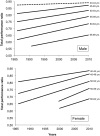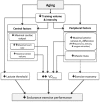Master Athletes Are Extending the Limits of Human Endurance
- PMID: 28018241
- PMCID: PMC5149541
- DOI: 10.3389/fphys.2016.00613
Master Athletes Are Extending the Limits of Human Endurance
Abstract
The increased participation of master athletes (i.e., >40 years old) in endurance and ultra-endurance events (>6 h duration) over the past few decades has been accompanied by an improvement in their performances at a much faster rate than their younger counterparts. Aging does however result in a decrease in overall endurance performance. Such age-related declines in performance depend upon the modes of locomotion, event duration, and gender of the participant. For example, smaller age-related declines in cycling performance than in running and swimming have been documented. The relative stability of gender differences observed across the ages suggests that the age-related declines in physiological function did not differ between males and females. Among the main physiological determinants of endurance performance, the maximal oxygen consumption (VO2max) appears to be the parameter that is most altered by age. Exercise economy and the exercise intensity at which a high fraction of VO2max can be sustained (i.e., lactate threshold), seem to decline to a lesser extent with advancing age. The ability to maintain a high exercise-training stimulus with advancing age is emerging as the single most important means of limiting the rate of decline in endurance performance. By constantly extending the limits of (ultra)-endurance, master athletes therefore represent an important insight into the ability of humans to maintain physical performance and physiological function with advancing age.
Keywords: aging; cycling; marathon; masters; performance; swimming; triathlon; ultra-endurance.
Figures


Similar articles
-
Trends in Triathlon Performance: Effects of Sex and Age.Sports Med. 2013 Sep;43(9):851-63. doi: 10.1007/s40279-013-0067-4. Sports Med. 2013. PMID: 23797729 Review.
-
Six-year follow-up of a world record-breaking master marathon runner.J Appl Physiol (1985). 2024 Nov 1;137(5):1354-1358. doi: 10.1152/japplphysiol.00474.2024. Epub 2024 Oct 3. J Appl Physiol (1985). 2024. PMID: 39359184
-
Applied physiology of triathlon.Sports Med. 1995 Apr;19(4):251-67. doi: 10.2165/00007256-199519040-00003. Sports Med. 1995. PMID: 7604198 Review.
-
Endurance exercise performance in Masters athletes: age-associated changes and underlying physiological mechanisms.J Physiol. 2008 Jan 1;586(1):55-63. doi: 10.1113/jphysiol.2007.141879. Epub 2007 Aug 23. J Physiol. 2008. PMID: 17717011 Free PMC article. Review.
-
Longitudinal Performance Analysis in Ultra-Triathlon of the World's 2 Best Master Triathletes.Int J Sports Physiol Perform. 2020 Jul 24;15(10):1480-1484. doi: 10.1123/ijspp.2019-0805. Int J Sports Physiol Perform. 2020. PMID: 32707562
Cited by
-
Aging and Possible Benefits or Negatives of Lifelong Endurance Running: How Master Male Athletes Differ from Young Athletes and Elderly Sedentary?Int J Environ Res Public Health. 2022 Oct 13;19(20):13184. doi: 10.3390/ijerph192013184. Int J Environ Res Public Health. 2022. PMID: 36293774 Free PMC article.
-
Physical Activity and Exercise for Cardiorespiratory Health and Fitness in Chronic Kidney Disease.Rev Cardiovasc Med. 2022 Jul 26;23(8):273. doi: 10.31083/j.rcm2308273. Rev Cardiovasc Med. 2022. PMID: 36945353 Free PMC article.
-
Hill Runner's Physiology, Performance and Nutrition: A Descriptive Study.Front Sports Act Living. 2021 Aug 17;3:676212. doi: 10.3389/fspor.2021.676212. eCollection 2021. Front Sports Act Living. 2021. PMID: 34485900 Free PMC article.
-
Maximising Triathlon Health and Performance: The State of the Art.Sports (Basel). 2025 Feb 21;13(3):66. doi: 10.3390/sports13030066. Sports (Basel). 2025. PMID: 40137790 Free PMC article.
-
An Analysis of Participation and Performance of 2067 100-km Ultra-Marathons Worldwide.Int J Environ Res Public Health. 2021 Jan 6;18(2):362. doi: 10.3390/ijerph18020362. Int J Environ Res Public Health. 2021. PMID: 33418867 Free PMC article.
References
-
- Allen W. K., Seals D. R., Hurley B. F., Ehsani A. A., Hagberg J. M. (1985). Lactate threshold and distance-running performance in young and older endurance athletes. J. Appl. Physiol. 58, 1281–1284. - PubMed
Publication types
LinkOut - more resources
Full Text Sources
Other Literature Sources
Miscellaneous

